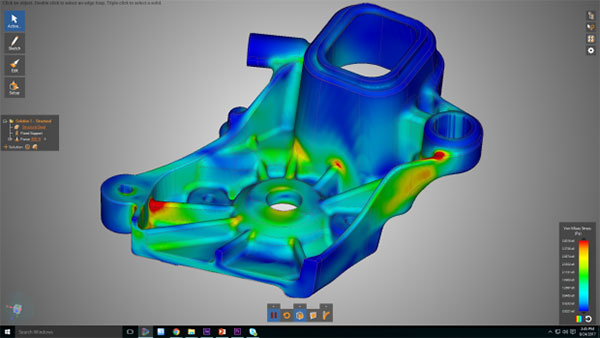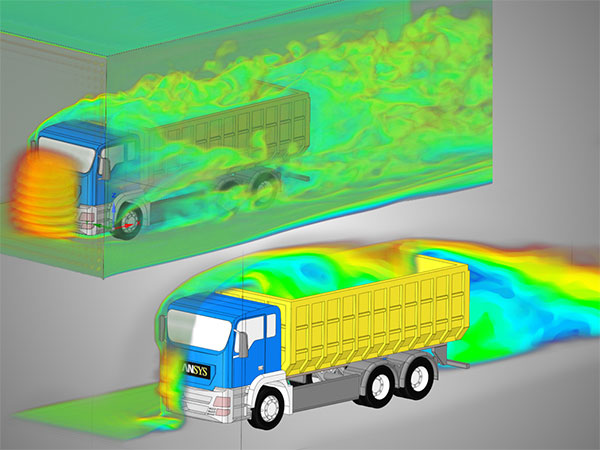Start Fast, Finish Faster
How quick simulations at the design concept stage can speed the entire product development process.

The ANSYS Discovery Live multiple physics exploration application is intended for designers and other engineers who do not normally use upfront simulation. It leverages the massive parallel processing power of NVIDIA GPUs (graphics processing units) to deliver a design environment where simultaneous visualization and simulation are possible. Image courtesy of ANSYS Inc.
Engineering Resource Center News
Engineering Resource Center Resources


Latest News
January 14, 2019
Speed vs. quality is an age-old dilemma for designers and engineers. In a world where products are increasingly measured by software version numbers that are updated many times a year or even many times a month, design engineers need every advantage to keep up. Waiting for a simulation specialist to make time to run high-fidelity simulations (which themselves can take hours or days) before a product concept is fully baked is not an inviting option. But until recently, that was the only option for design engineering teams who wanted to cut down on the time and expense associated with iterative physical testing.
As reported previously, simulation-led design offers a path to the promised land of high-quality products designed and developed more quickly. While many advances have been made, such as embedding simulation functionality into CAD software, the speed vs. quality conundrum persists. It still takes time and skill to create or modify a model. The model then needs to be prepared via a process known as de-featuring to remove all the unnecessary details that don’t need to be simulated and could botch the job. Once the model is ready, it can be meshed for finite element analysis (FEA). The simulation is then ready to run and, if it was prepared correctly, the results can be analyzed. If something was amiss, or if you want to make a significant design change, the process begins again.
Push the Simulate Button
Simulation is faster and more affordable than physical testing in many use cases, but it’s not always fast enough to satisfy the deadline pressures being placed on design engineering teams. Where are the push-button results that would make simulation an interactive, upfront process?
“I feel every sympathy for a designer, using a CAD-embedded FEA program, who wants to assess the approximate strength of a design as early as possible,” writes consulting analyst Tony Abbey in the January issue of DE. “In the broader context of loads, boundary conditions and modeling techniques, there really are no shortcuts.”
However, in the specific context of design concepts, there is incredible value in visualizing approximations of FEA early in the design process. Dedicated simulation analysts might scoff at the notion of using a simulation with an accuracy in the range of 10% to 20%, but that’s all many design engineers need to verify that the design concept is moving in the right direction, or to make early course corrections. Even better, thanks to software like ANSYS Discovery Live, such simulations can be done in near real-time so that modifying a model and simulating those changes becomes an interactive experience.

Immersive Interaction
“With ANSYS Discovery Live, the geometry environment is provided by ANSYS SpaceClaim. The other key technology, in addition to meshless FEA, is the use of NVIDIA graphics processing units (GPU) to provide very fast analysis time for models with very large numbers of elements (a typical model used in the demonstration had 15 million elements),” writes Abbey after getting a demo of the software from Justin Hendrickson, product manager for ANSYS Discovery Live. “The result of this is that analysis is continuously available, and any design change is automatically reflected in a new analysis. One loses the concept of an analysis ‘run,’ and it is more of a continuous flow of updated stress and displacement results. This becomes a very immersive experience and provides immediate and intuitive feedback on design changes.”
ANSYS Discovery Live makes use of CUDA, NVIDIA’s parallel computing and programming platform to make that immersive experience possible, and it’s not limited to structural simulation. Structural, internal and external fluid flow, thermal and modal issues can all be interactively simulated at the concept stage to drive the optimal design forward.
“There are two aspects that attract me to Discovery Live. First, all Discovery Live simulations are inherently time-dependent and naturally result in appealing and intuitive flow visualizations showing unsteady behavior. The second thing that grabs me is the ease with which a modification to a geometry can be introduced into the simulation,” writes Stewart Bible and Caleb Triece, P.E, of Resolved Analytics, in a post last month. “This capability is, at its worst, a novel and beautiful use of direct 3D modeling technology and, at its best, a disruptive breakthrough that will be a model for all future CFD (computational fluid dynamics) programs.”
Subscribe to our FREE magazine, FREE email newsletters or both!
Latest News






